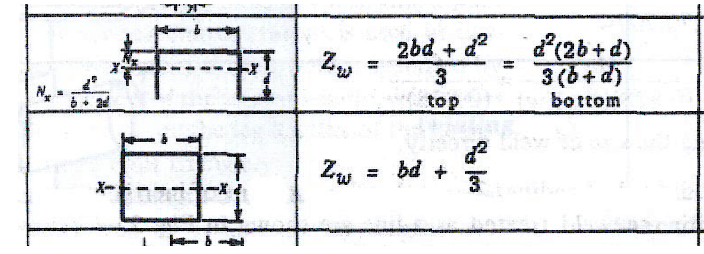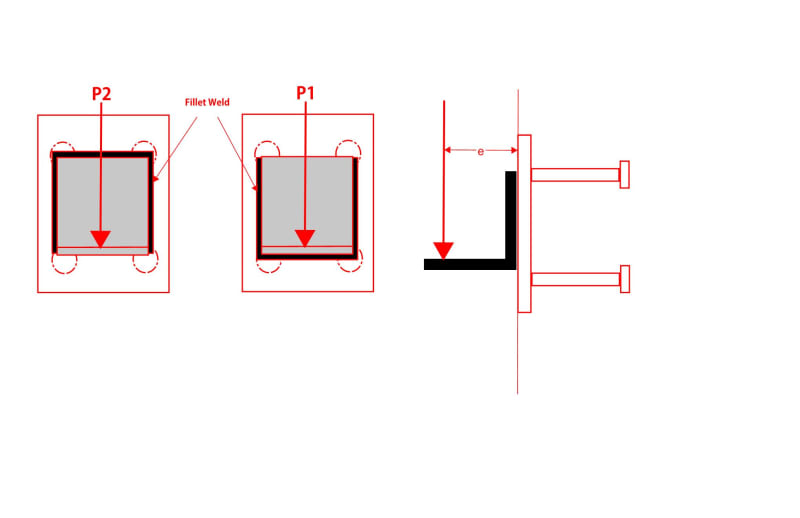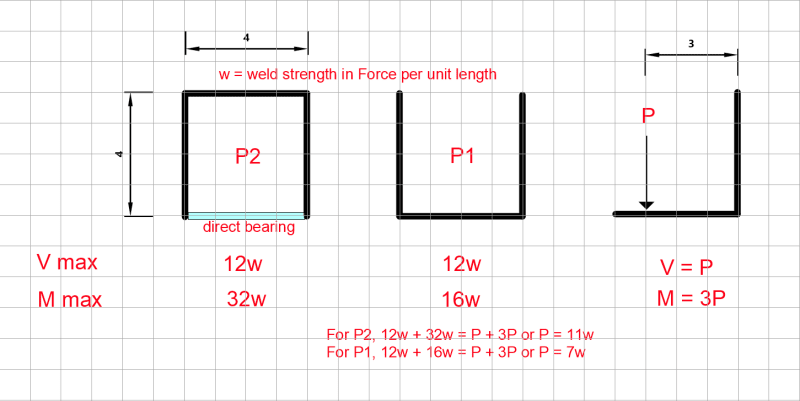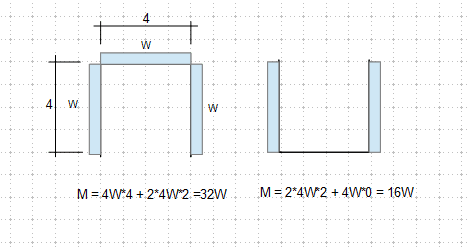-
1
- #1
Navigation
Install the app
How to install the app on iOS
Follow along with the video below to see how to install our site as a web app on your home screen.
Note: This feature may not be available in some browsers.
More options
Style variation
-
Congratulations cowski on being selected by the Eng-Tips community for having the most helpful posts in the forums last week. Way to Go!
You are using an out of date browser. It may not display this or other websites correctly.
You should upgrade or use an alternative browser.
You should upgrade or use an alternative browser.
Welding Capacity Calculation 7
- Thread starter JohnRwals
- Start date
- Status
- Not open for further replies.
I'm almost positive that every All-Welded Unstiffened Seat connection or Extended Shear Plate if pulled from the AISC tables have been designed on the assumption that the welds transfer the force to the underlying supporting member. Now the AISC detail for the Unstiffened seat only has a minimal return weld which I believe is because a full transverse weld ends up loaded in dominantly out of plane tension which if I'm remembering correctly has a pretty brittle failure mode (edit: I think my memory is off here I think its the vertical shear not the tension, since in theory the vertical shear load angle relative to the weld axis is 90 degrees which would let you take a multiplier on the weld capacity, but I think the end result wouldn't align with the ductility assumptions for the "pinned" connection. Need to reread the spec section on the topic)BAretired said:Perhaps, but how many engineers would do that?
So back tracking a bit the better connection detail would be to match the AISC recomendations.
My Personal Open Source Structural Applications:
Open Source Structural GitHub Group:
Celt83 hit the nail on the head in his second post on the 12th October if we are solely looking at the weld strength capacity then the two configurations would be the same. Fillet welds are designed based on shear stress whether it be shear stress from bending on the tension or compression side of the beam. The simple analysis carried out by treating welds as lines tends to be on the safe side and in addition a designer would use a safety factor on the stresses in any case.
So provided the shear stress is kept within allowable limits for the external load applied to the angle it doesn’t matter which way round the angles welded.
“Do not worry about your problems with mathematics, I assure you mine are far greater.” Albert Einstein
So provided the shear stress is kept within allowable limits for the external load applied to the angle it doesn’t matter which way round the angles welded.
“Do not worry about your problems with mathematics, I assure you mine are far greater.” Albert Einstein
The question was:
Whatever AISC, Celt83 or desertfox says, I think the answer is P2.
EDIT: In fact if they were both built properly , P2 would be a great deal more than P1.
BA
JohnRwals (OP) said:Which one do you think can support greater load? Why?
Whatever AISC, Celt83 or desertfox says, I think the answer is P2.
EDIT: In fact if they were both built properly , P2 would be a great deal more than P1.
BA
BA,
From analytical point of view, all mentioned parties are correct. You are correct on your conviction, from material strength point of view, as there are literatures indicating that the transverse weld has higher strength than the vertical weld. Correct me, if I am wrong.
From analytical point of view, all mentioned parties are correct. You are correct on your conviction, from material strength point of view, as there are literatures indicating that the transverse weld has higher strength than the vertical weld. Correct me, if I am wrong.
r13 said:From analytical point of view, all mentioned parties are correct. You are correct on your conviction, from material strength point of view, as there are literatures indicating that the transverse weld has higher strength than the vertical weld. Correct me, if I am wrong.
You are not wrong about the strength of a weld at 0 or 90 degrees to the line of the weld, but there is the same amount of transverse weld in both schemes, so that does not account for my statement above.
The reason is simply that the top transverse weld has a moment arm equal to the height of the angle. The bottom weld does not. In both cases, failure will be by the angle rotating about the bottom. Scheme P1 will fail by tearing of the vertical weld at the top. Scheme P2 will fail when the top transverse weld pulls away from the embed plate while the bottom of the angle bears directly against the embed plate without the need of a weld. The difference between load P1 and P2 will be substantial.
BA
- Thread starter
- #47
Wow! This is not a simple problem.
Thank you very much for diverse opinions!
I would like to use r13's elastic analysis approach which referred to the specific condition of M=P*e=1.
According to r13's analysis, as P (M) increases, failure will start where stress 0.035 is with M=1.
These failures happen at the end tips of vertical welding portion (farthest from horizontal welding);
P2 at the compression (bottom) area, and P1 at the tension (top) area.
In the case of P2, the bottom edge of angle can take compression after welding is crushed
if contact/bearing between angle and embed plate is possible as some engineers mentioned.
But, in the case of P1, as soon as failure starts at the end tip of welding, it will proceed like brittle failure.
Therefore, P1 and P2 have the same capacity as long as they are within the elastic limit.
But, beyond the elastic limit, P1 will cause brittle failure
while P2 can resist additional load as long as it can take advantage of bearing strength from embed plate.
So, P2 is better as some engineers' intuition pointed to...
Questions/Lessons:
Do you check the compression stress, compression failure of welding?
Many engineers used elastic analysis. What about inelastic/plastic method?
Don't they provide another insight?
Thanks!
JRW
JohRwals said:Therefore, P1 and P2 have the same capacity as long as they are within the elastic limit.
Even if that were true, that is not the capacity by definition. The capacity is the failure load and that does not occur while everything is elastic.
But beyond that, even within the elastic limit, the two schemes are not equivalent because in scheme P2, the bottom of the angle bears directly against the embed plate. That is equivalent to a full transverse weld in compression which cannot resist applied shear.
BA
BA,
We have to set the two conditions on a equal base. In general, we won't adopt P1 for many practical reasons, but if necessary (for no choice), would configuration of P1 support a lesser load than P2, assuming all other materials are adequately sized for the load. The failure mode addressed by you is one of the practical reason that we shy away from P1, but it does not affect the designed strength, if designed/calculated correctly. I think we are recognizing/responding the OP's question from different angles, though the conclusion is the same - The weld configuration of P1 and P2 will yield same computational strength, but P2 is preferred for practicalities.
We have to set the two conditions on a equal base. In general, we won't adopt P1 for many practical reasons, but if necessary (for no choice), would configuration of P1 support a lesser load than P2, assuming all other materials are adequately sized for the load. The failure mode addressed by you is one of the practical reason that we shy away from P1, but it does not affect the designed strength, if designed/calculated correctly. I think we are recognizing/responding the OP's question from different angles, though the conclusion is the same - The weld configuration of P1 and P2 will yield same computational strength, but P2 is preferred for practicalities.
r13 said:the conclusion is the same - The weld configuration of P1 and P2 will yield same computational strength, but P2 is preferred for practicalities.
That seems to be what you are saying. It is not what I am saying. If properly constructed, P1 and P2 do not yield the same strength, computational or otherwise. Scheme P2 is preferred because it is stronger.
BA
weld stresses are complex but we have a simple analysis which allows us to calculate the average shear stresses in the welds and with given safety factors and a few assumptions the analysis errs on the safe side.
Now if you use this analysis it would show that the weld shearing stresses for the two configurations would be the same in magnitude and as previously stated if within the elastic limit of the materials involved, the use of either would suffice, why would one want to start analyzing what happens after yield, at that point the joints already failed at the design stage.
How then do we calculate the additional force or the additional strength that P2 will give us over P1?
Or put another way lets see the calculation that shows the magnitude of P2 and compare it with that of P1 bearing in mind we can calculate P1 from weld stress analysis of treating welds as lines.
“Do not worry about your problems with mathematics, I assure you mine are far greater.” Albert Einstein
Now if you use this analysis it would show that the weld shearing stresses for the two configurations would be the same in magnitude and as previously stated if within the elastic limit of the materials involved, the use of either would suffice, why would one want to start analyzing what happens after yield, at that point the joints already failed at the design stage.
How then do we calculate the additional force or the additional strength that P2 will give us over P1?
Or put another way lets see the calculation that shows the magnitude of P2 and compare it with that of P1 bearing in mind we can calculate P1 from weld stress analysis of treating welds as lines.
“Do not worry about your problems with mathematics, I assure you mine are far greater.” Albert Einstein
I think the point is that with the load being out of the plane of the weld group, there is tension or tearing action in addition to vertical shear on the upper two corners of the weld in example P1. Given that this is where the weld starts or ends, there is a greater chance of a discontinuity that would propogate and cause a failure, particularly if the load was cycled or large enough to cause significant deformation of the angle. The weld group in P2 has much greater ability to resist this. In my opinion, P2 has a much greater chance of sucess over the life of the attachment. The overhead weld in P1 also makes it worse, in my opinion. Now, if the angle was a 6 x 6 x 1 and the force was 25 pounds then both weld groups are OK but I'd still go for the one that was easier in the field or shop.
BAretired
Cant see how you get Mmax for P2?
Looking in Mechanical engineers data by james Carvill the Z value for the weld treated as a line at position P2 is given by
Z= (2bd+d^2)t/3 at the top
Z= d^2(2b+d)t/(3(b+d)) at the bottom
Z = bending modulus, d = depth , b= width
So the bending modulus Z at the top and bottom are different as stated by others in previous posts, however it doesn't matter which way up you weld the the angle all that happens is the Z values top to bottom switch over but the overall capacity of the weld to take bending remains the same, which is exactly what Celt83 stated on the 12th October, or at least thats how I read it.
“Do not worry about your problems with mathematics, I assure you mine are far greater.” Albert Einstein
Cant see how you get Mmax for P2?
Looking in Mechanical engineers data by james Carvill the Z value for the weld treated as a line at position P2 is given by
Z= (2bd+d^2)t/3 at the top
Z= d^2(2b+d)t/(3(b+d)) at the bottom
Z = bending modulus, d = depth , b= width
So the bending modulus Z at the top and bottom are different as stated by others in previous posts, however it doesn't matter which way up you weld the the angle all that happens is the Z values top to bottom switch over but the overall capacity of the weld to take bending remains the same, which is exactly what Celt83 stated on the 12th October, or at least thats how I read it.
“Do not worry about your problems with mathematics, I assure you mine are far greater.” Albert Einstein
For limit state, the area above and below the neutral axis are the same, so the ultimate tension and compression are identical, as well as the lever arm, for P1 and P2 both. However, P2 is superior, if we consider the additional capacity of the weld in direction transverse to load (horizontal weld), which was conservatively ignored by the code.
Here is a reference to analysing welds and the assumptions made:-
“Do not worry about your problems with mathematics, I assure you mine are far greater.” Albert Einstein
“Do not worry about your problems with mathematics, I assure you mine are far greater.” Albert Einstein
Settingsun
Structural
I recall reading once that you should only consider the welded length as transferring load unless special effort is made to ensure contact for bearing. Eg the angle could be slightly warped so you don't get the bearing along the bottom edge, at least not initially. I couldn't easily find the document though to re-read all the comments.
desertfox:
I have included a snippet from your reference below. Please note that in North America, the symbol Z represents plastic modulus and the symbol S represents section modulus. I was (or thought I was) using plastic properties for my calculations. I'm not sure why that is wrong, but in any event, that is not the main source of our difference. In fact, using your formulas, the discrepancy is even larger.

Using your formulas and recognizing bearing at the bottom of the angle, the failure load of P2 in bending is 2.67 that of P1.
P1 = 8w/3 = 2.67w whereas P2 = 21.3w/3 = 7.11w.
It boils down to the question of whether or not you recognize direct bearing of the angle against the embed plate. If you do (and I do) then the P2 connection is much superior to P1.
Even if you don't recognize direct bearing, P1 is liable to unzip at the top of the vertical welds whereas P2, at worst will crush a bit of side weld, causing it to come into direct bearing with the embed plate.
BA
I have included a snippet from your reference below. Please note that in North America, the symbol Z represents plastic modulus and the symbol S represents section modulus. I was (or thought I was) using plastic properties for my calculations. I'm not sure why that is wrong, but in any event, that is not the main source of our difference. In fact, using your formulas, the discrepancy is even larger.

desertfox said:BAretired[/color]]
Cant see how you get Mmax for P2?
Looking in Mechanical engineers data by james Carvill the Z value for the weld treated as a line at position P2 is given by
Z= (2bd+d^2)t/3 at the top . . If b = d = 4 then Zw = 16 (top of P2, ignoring direct bearing)
Z = bd + d2/3 top or bottom of P2, recognizing direct bearing . . Zw = 16 + 16/3 = 21.3
Z= d^2(2b+d)t/(3(b+d)) at the bottom . . Zw = 8 (top of P1)
Z = bending modulus, d = depth , b= width
So the bending modulus Z at the top and bottom are different as stated by others in previous posts, however it doesn't matter which way up you weld the the angle all that happens is the Z values top to bottom switch over but the overall capacity of the weld to take bending remains the same, which is exactly what Celt83 stated on the 12th October, or at least thats how I read it.
Using your formulas and recognizing bearing at the bottom of the angle, the failure load of P2 in bending is 2.67 that of P1.
P1 = 8w/3 = 2.67w whereas P2 = 21.3w/3 = 7.11w.
It boils down to the question of whether or not you recognize direct bearing of the angle against the embed plate. If you do (and I do) then the P2 connection is much superior to P1.
Even if you don't recognize direct bearing, P1 is liable to unzip at the top of the vertical welds whereas P2, at worst will crush a bit of side weld, causing it to come into direct bearing with the embed plate.
BA
BAretired
The treatment of welds as lines doesn’t recognise direct bearing if you look at the last link I gave on the first page it clearly states that the weld only is analysed it also makes reference to Blodget and various other references including Shigley.
So by assuming that the weld only carries the load for either configuration is a more conservative calculation, further if there is no direct bearing as the last poster steveh49 alludes to then you could end up with at joint that fails.
“Do not worry about your problems with mathematics, I assure you mine are far greater.” Albert Einstein
The treatment of welds as lines doesn’t recognise direct bearing if you look at the last link I gave on the first page it clearly states that the weld only is analysed it also makes reference to Blodget and various other references including Shigley.
So by assuming that the weld only carries the load for either configuration is a more conservative calculation, further if there is no direct bearing as the last poster steveh49 alludes to then you could end up with at joint that fails.
“Do not worry about your problems with mathematics, I assure you mine are far greater.” Albert Einstein
- Status
- Not open for further replies.
Similar threads
- Replies
- 8
- Views
- 14K
- Replies
- 7
- Views
- 3K
- Replies
- 56
- Views
- 16K
- Locked
- Question
- Replies
- 9
- Views
- 2K
- Replies
- 8
- Views
- 5K



